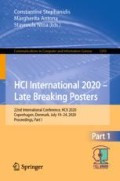Abstract
This paper describes the setup and results of a qualitative interview study, in which participants were given the opportunity to interact with an AI-based representation of a robotic-arm in a virtual reality environment. Nine participants were asked to jointly assemble a product with their robotic partner. The different aspects of their experiences, expectations and preferences towards the interaction with the AI-based industrial collaboration partner were assessed. Results of this study help to inform the design of future studies exploring working arrangements and communication between individuals and robots in collaborating together.
Access this chapter
Tax calculation will be finalised at checkout
Purchases are for personal use only
References
Arntz, A., Eimler, S., Handmann, U.: Artificial intelligence driven human-machine collaboration scenarios in virtual reality (poster) (2018). http://www.handmann.net/pdf/IA-Poster-ArnEimHan2018.pdf
Embgen, S., Luber, M., Becker-Asano, C., Ragni, M., Evers, V., Arras, K.: Robot-specific social cues in emotional body language. In: Proceedings - IEEE International Workshop on Robot and Human Interactive Communication, pp. 1019–1025, September 2012. https://doi.org/10.1109/ROMAN.2012.6343883
Ende, T., Haddadin, S., Parusel, S., Wüsthoff, T., Hassenzahl, M., Albu-Schäeffer, A.: A human-centered approach to robot gesture based communication within collaborative working processes, pp. 3367–3374, September 2011. https://doi.org/10.1109/IROS.2011.6094592
de Giorgio, A., Romero, M., Onori, M., Wang, L.: Human-machine collaboration in virtual reality for adaptive production engineering. Proc. Manuf. 11, 1279–1287 (2017). https://doi.org/10.1016/j.promfg.2017.07.255
Hermann, M., Pentek, T., Otto, B.: Design principles for industrie 4.0 scenarios: a literature review, January 2015. https://doi.org/10.13140/RG.2.2.29269.22248
Kirschner, D., Velik, R., Yahyanejad, S., Brandstötter, M., Hofbaur, M.: YuMi, come and play with me! A collaborative robot for piecing together a tangram puzzle. In: Ronzhin, A., Rigoll, G., Meshcheryakov, R. (eds.) ICR 2016. LNCS (LNAI), vol. 9812, pp. 243–251. Springer, Cham (2016). https://doi.org/10.1007/978-3-319-43955-6_29
Mueller-Abdelrazeq, S.L., Stiehm, S., Haberstroh, M., Hees, F.: Perceived effects of cycle time in human-robot-interaction. In: 2018 IEEE Workshop on Advanced Robotics and its Social Impacts (ARSO), pp. 25–30. IEEE (2018). (27092018–29092018). https://doi.org/10.1109/ARSO.2018.8625819
Scheunemann, M.M., Salge, C., Dautenhahn, K.: Intrinsically motivated autonomy in human-robot interaction: human perception of predictive information in robots. In: Althoefer, K., Konstantinova, J., Zhang, K. (eds.) TAROS 2019. LNCS (LNAI), vol. 11649, pp. 325–337. Springer, Cham (2019). https://doi.org/10.1007/978-3-030-23807-0_27
Shah, J., Wiken, J., Williams, B., Breazeal, C.: Improved human-robot team performance using chaski, a human-inspired plan execution system. In: Billard, A., Kahn, P., Adams, J.A., Trafton, G. (eds.) Proceedings of the 6th International Conference on Human-Robot Interaction - HRI 2011, p. 29. ACM Press, New York (2011). https://doi.org/10.1145/1957656.1957668
Straßmann, C.: All eyes on the agent’s appearance?!: Investigation of target-group-related social effects of a virtual agent’s appearance in longitudinal human-agent interactions. Ph.D. thesis, June 2018
Straßmann, C., von der Pütten, A.R., Yaghoubzadeh, R., Kaminski, R., Krämer, N.: The effect of an intelligent virtual agent’s nonverbal behavior with regard to dominance and cooperativity. In: Traum, D., Swartout, W., Khooshabeh, P., Kopp, S., Scherer, S., Leuski, A. (eds.) IVA 2016. LNCS (LNAI), vol. 10011, pp. 15–28. Springer, Cham (2016). https://doi.org/10.1007/978-3-319-47665-0_2
European Union: Special eurobarometer 382: public attitudes towards robots (2014). https://data.europa.eu/euodp/de/data/dataset/S1044_77_1_EBS382. Accessed 13 Mar 2020
Yanco, H., Drury, J.: A taxonomy for human-robot interaction, pp. 111–119, December 2002
Zheng, P., Sang, Z., Zhong, R., Liu, Y.: Manufacturing systems for industry 4.0: conceptual framework, scenarios and future perspectives. Front. Mech. Eng. 13, 137–150 (2018)
Acknowledgments
The authors thank Prof. Dr. H. Ulrich Hoppe, Dustin Keßler, Nele Borgert, Dr. Carolin Straßmann and Sarah Zielinski for their contributions, comments and reviews regarding the study design and execution, as well as all participants contributing to the study.
Author information
Authors and Affiliations
Corresponding author
Editor information
Editors and Affiliations
Rights and permissions
Copyright information
© 2020 Springer Nature Switzerland AG
About this paper
Cite this paper
Arntz, A., Eimler, S.C. (2020). Experiencing AI in VR: A Qualitative Study on Designing a Human-Machine Collaboration Scenario. In: Stephanidis, C., Antona, M., Ntoa, S. (eds) HCI International 2020 – Late Breaking Posters. HCII 2020. Communications in Computer and Information Science, vol 1293. Springer, Cham. https://doi.org/10.1007/978-3-030-60700-5_38
Download citation
DOI: https://doi.org/10.1007/978-3-030-60700-5_38
Published:
Publisher Name: Springer, Cham
Print ISBN: 978-3-030-60699-2
Online ISBN: 978-3-030-60700-5
eBook Packages: Computer ScienceComputer Science (R0)

